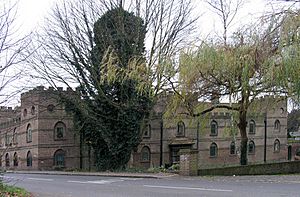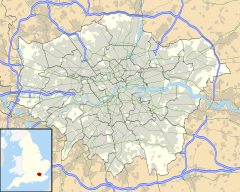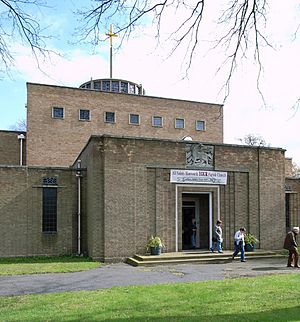Hanworth facts for kids
Quick facts for kids Hanworth |
|
|---|---|
 Tudor House in Castle Way, Hanworth. |
|
| Area | 6.89 km2 (2.66 sq mi) |
| Population | 23,563 (Hanworth, Hanworth Park wards 2011) |
| • Density | 3,420/km2 (8,900/sq mi) |
| OS grid reference | TQ3682 |
| London borough | |
| Ceremonial county | Greater London |
| Region | |
| Country | England |
| Sovereign state | United Kingdom |
| Post town | FELTHAM |
| Postcode district | TW13 |
| Dialling code | 020 |
| Police | Metropolitan |
| Fire | London |
| Ambulance | London |
| EU Parliament | London |
| UK Parliament |
|
| London Assembly |
|
Hanworth is a lively area in West London, England. It used to be part of Middlesex but became part of the London Borough of Hounslow in 1965. Hanworth is located near other towns like Feltham, Twickenham, Hampton, and Sunbury-on-Thames.
The name "Hanworth" probably comes from old Anglo-Saxon words. "Haen/han" means "small" and "worth" means "homestead" or "farm." So, it likely meant "small farm."
Contents
History of Hanworth
Hanworth has a long and interesting history, going back to the time of Edward the Confessor, a king of England before the Norman Conquest.
Early Days and Royal Connections
Around the time of Edward the Confessor, Hanworth was a small area with few people. It was a "manor," which was a large estate with a village and land, owned by a lord. A man named Ulf, who was a "huscarl" (a special bodyguard to the king), owned it. Most huscarls died in the Battle of Hastings in 1066.
After William the Conqueror took over England, he gave Hanworth to Robert, under the control of Roger de Montgomery. Later, the land changed hands several times, often due to rebellions against the king.
In the late 1300s, Sir Nicholas Brembre, who was the Mayor of London, owned the manor. He faced serious charges in 1387.
In 1512, Hanworth became property of the Crown, meaning the King owned it. Henry VIII loved hunting on Hounslow Heath, which was nearby. He gave the Hanworth manor to his wife, Anne Boleyn. After her execution, the manor returned to the King.
Later, Henry VIII's last wife, Catherine Parr, lived in the Hanworth house with her stepdaughter, Princess Elizabeth. When Princess Elizabeth became Queen, she often visited Hanworth Manor to hunt.
Mapping Britain and Changes to the Manor
In 1784, a military mapmaker named General Sir William Roy led an important project. They measured a long line across Hounslow Heath, passing through Hanworth Park. This measurement was the starting point for all future maps of the United Kingdom, including the Ordnance Survey maps we use today.
Sadly, in 1797, the main manor house was destroyed by fire. Only the stable block and coach house remained. These buildings were later turned into homes. Tudor House, which you can see today, was built in 1875 where the old manor house once stood. It is now also used as flats.
By the late 1800s, William Whiteley, who owned the famous Whiteley's department store in Bayswater, bought a large area of farmland in Hanworth. He called it Hanworth Farms. These farms supplied all the fresh food for his store. After Whiteley died, his sons sold the farm to a jam maker. Later, in 1933, the land was sold again to build new homes.
Important Owners of Hanworth Manor
Many important people owned or were connected to the Hanworth Park estate. One was Baron Cottington of Hanworth, who was an ambassador for King Charles I. He was a strong supporter of the King during the English Civil War. After the war, his lands were taken away but later returned to his family.
The manor was then sold to Sir Thomas Chamber. Later, it passed to Vere Beauclerk, who became Baron Vere of Hanworth. His son, Aubrey, inherited it and later became the Duke of St. Albans. The manor continued to change hands among notable families and individuals over the centuries.
Churches in Hanworth
Hanworth has two main churches, each with its own history.
Saint George's Church
Hanworth's main church is called Saint George's Church. It has been on its current site in Castle Way since at least the 1300s. The first known leader of the church was Adam de Brome, who founded Oriel College, Oxford, in 1309.
All Saints Church
In 1935, Hanworth's population was growing, partly because of the jam factory. People decided that a smaller, simpler church was needed. It was started by Bertram Pollock, who was the Bishop of Norwich and had been born in Hanworth. Part of his childhood home was used as the first chapel.
After World War II, a new, proper church was planned. The architect Nugent Cachemaille-Day designed it. The new church, called All Saints, was built on Hampton Road West. Its foundation stone was laid in 1951, and the church was officially opened in 1957.
Hanworth Aerodrome
Hanworth Aerodrome was a grass airfield that was used from 1917-1919 and again from 1929-1947. It was located in Hanworth Park. In the 1930s, it was known as London Air Park and was a popular place for private flying and social events.
Aircraft were also made there by a company called General Aircraft Limited (GAL). A very famous airship, the Graf Zeppelin, even visited in 1932!
A famous pilot, Amelia Earhart, flew to Hanworth in 1932 after she became the first woman to fly solo across the Atlantic Ocean. There's a pub nearby called "The Airman" to remember the aerodrome. The park was bought by the local council in 1956. Later, a swimming pool and leisure centre were built on the parkland, which is now called Hanworth Air Park Leisure Centre & Library.
Hanworth in the 1970s
In the 1970s, a new elevated road, part of the A316, was built. This road cut Hanworth into two parts. Because of this, the local library was moved to a new spot called Mount Corner. A new school, Forge Lane Infants and Junior School, was built on the south side of the new road, and the war memorial was also moved.
Sport and Leisure in Hanworth
Hanworth offers several sports and leisure activities for its residents.
- Hanworth Villa F.C. is a local football club that plays at Rectory Meadow.
- Feltham Rugby Football Club, founded in 1947, has its home at Hanworth Air Park.
- Hanworth Sports FC has also been based at Hanworth Air Park since 2002.
- The Hanworth Air Park Leisure Centre & Library has a gym and a swimming pool, offering great ways to stay active.
- Staines Rugby Football Club also plays and trains at a rugby ground in Snakey Lane.
Geography of Hanworth
Hanworth is a relatively flat area. The soil is a mix of gravel and clay, with some rich soil near the streams.
Waterways and Elevation
Two main streams flow through Hanworth. The River Crane forms much of the northern border, and the Port Lane stream runs along the western edge. Both of these streams flow into the River Thames in nearby areas. The land in Hanworth is mostly flat, with elevations ranging from 11 to 16 meters above sea level.
Nearby Areas
Hanworth is surrounded by several other towns and districts:
 |
Southall | across parkland of Hounslow Heath and a railway Hounslow West |
Whitton |  |
| Feltham | Whitton Twickenham Hampton Hill |
|||
| Cranford, London | Hampton | Sunbury-on-Thames |
Transport in Hanworth
Getting around Hanworth and to other parts of London is easy with various transport options.
Train Stations
The closest train stations serving Hanworth are:
- Feltham railway station (on the northern edge of Hanworth)
- Hampton
- Kempton Park
Underground (Tube) Stations
There are no London Underground stations directly in Hanworth. The nearest ones are:
- Hounslow East tube station (to the north)
- Hatton Cross tube station (to the west)
Both of these stations are on the Heathrow branch of the Piccadilly line.
Bus Routes
Several London bus routes serve Hanworth, connecting it to surrounding areas:
Notable People from Hanworth
Many interesting people have connections to Hanworth:
- Henry Killigrew (1613-1700), a playwright and chaplain to the future King James II, was born in Hanworth.
- Edward Seymour, 1st Earl of Hertford (1539-1621) was moved to Hanworth from the Tower of London in 1563.
- The Viscounts Hanworth, especially the first Viscount, had their family home at Hanworth Park.
- Bertram Pollock (1863-1943), who became the Bishop of Norwich, was born in Hanworth.
- Elizabeth I, who later became Queen, lived in Hanworth in the 1540s with her stepmother, Catherine Parr, who was Henry VIII's sixth wife.
- A person named David Copeland who committed serious crimes lived here for a while.
Homes and Population in Hanworth
Here's a look at the types of homes and the population in Hanworth, based on the 2011 Census:
| Ward | Detached | Semi-detached | Terraced | Flats and apartments | Caravans/temporary/mobile homes/houseboats | Shared between households |
|---|---|---|---|---|---|---|
| Hanworth | 175 | 1,347 | 1,370 | 1,748 | 4 | 7 |
| Hanworth Park | 309 | 1,534 | 1,146 | 1,479 | 8 | 9 |
| Ward | Population | Households | % Owned outright | % Owned with a loan | hectares |
|---|---|---|---|---|---|
| Hanworth | 12,155 | 4,651 | 18 | 29 | 325 |
| Hanworth Park | 11,408 | 4,485 | 25 | 36 | 364 |
The 2011 census also showed the different ethnic groups living in Hanworth:
- 58.5% White British
- 9% Other White (not including Irish/Gypsy)
- 17.9% Asian
- 6.9% Black



